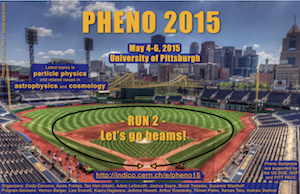Speaker
Ms
nilanjana kumar
(Geaduate student)
Description
The performance of LHC and the results already achieved have been
outstanding. The lightest Higgs scalar boson mass in supersymmetry can be
raised significantly by extra vector-like quark and lepton supermultiplets with
large Yukawa couplings but dominantly electroweak-singlet masses.
We are interested in a model consisting of a ${\bf 10} + {\bf \overline{10}}$
of $SU(5)$. The non-MSSM particles in this case consist of charge $+2/3$ quarks
$t'_{1,2}$, a charge $-1/3$ quark $b'$, and a charged lepton $\tau'$,
and their scalar partners. We assumed that the mixing of the new fermions with Standard Model fermions
is large enough to provide for prompt decays. Mixing with the third Standard
Model family are considered, for which the constraints are much easier to satisfy.
\\
We gave attention to the vector like lepton $\tau'$. $\tau'$ can decay to $W\nu$, $Z\tau$, and $h^0 \tau$.
Because there is only one relevant Yukawa mixing term, the branching
ratios depend only on $m_{\tau'}$.
The largest branching ratio for $\tau'$ is always to $W\nu$. The most immediately relevant searches at
hadron colliders will be in the mass range of $m_{\tau'}$ just above
100 GeV, where the electroweak pair-production cross-section can be
sufficiently large. We have shown that there are certain
multilepton channels with a good possibility to observe desired signal
over the backgrounds at 13 TeV. In order to do this we have implemented
particular cuts to select events that are useful. We also considered some of the more
optimistic scenarios where one of the branching ratio to $W\nu$,
$Z\tau$, and $h^0\tau$ are close to 1.
Author
Ms
nilanjana kumar
(Geaduate student)
Co-author
Dr
Stephen Martin
(Professor)
